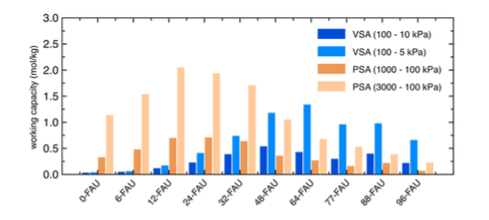Optimal Faujasite structures for post combustion CO2 capture and separation in different swing adsorption processes
Optimal Faujasite structures for post combustion CO2 capture and separation in different swing adsorption processes
H. Prats, D. Bahamón, G. Alonso, X. Giménez, P. Gamallo, R. Sayós.
J. CO2 Util., 19 (2017) 100.

Calculated CO2 working capacities for the ten FAU structures considered corresponding to PSA and VSA
processes at different pressures and at 313 K.
Grand Canonical Monte–Carlo simulations are used in this work, to assess optimum faujasite structures in CO2 capture processes. Pressure Swing Adsorption (PSA) and Vacuum Swing Adsorption (VSA) procedures have been considered to evaluate purity, working capacity and breakthrough time. To this purpose, ten faujasite structures with different Al content were selected, and the best conditions for CO2 capture maximization have been calculated for each structure. Further results show that zeolites having intermediate Al content are the most effective for VSA processes, whereas low Al content faujasites perform better at PSA conditions. Remarkably, present work best results clearly improve faujasite 13X VSA–PSA performances, so far considered the industrial reference in absence of water. Moreover, combined VPSA processes, in terms of working capacity and adiabatic work required for compression/expansion, have also been studied, showing that VPSA systems are more efficient than pure PSA/VSA, for structures with intermediate Al content. Finally, an improved methodology has been derived, where mixture isotherms and energetic cost calculations are combined, and a more accurate way of estimating working capacities and breakthrough times is proposed.
